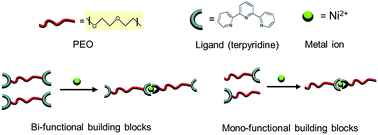Controlling the melt rheology of linear entangled metallo-supramolecular polymers†
Abstract
We study in the melt the linear viscoelastic properties of supramolecular assemblies obtained by adding different amounts of nickel ions to linear entangled poly(ethylene oxide) (PEO) building blocks end-functionalized by a terpyridine group. We first show that the elasticity of these supramolecular assemblies is mainly governed by the entanglement dynamics of the building blocks, while the supramolecular interactions delay or suppress their relaxation. By adjusting the amount of metal ions, the relaxation time as well as the level of the low-frequency plateau of these supramolecular assemblies can be controlled. In particular, the addition of metal ions above the 1 : 2 metal ion/terpyridine stoichiometric ratio allows secondary supramolecular interactions to appear, which are able to link the linear supramolecular assemblies and thus, lead to the reversible gelation of the system. By comparing the rheological behavior of different linear PEO samples, bearing or not functionalized chain-ends, we show that these extra supramolecular bonds are partially due to the association between the excess of metal ions and the oxygen atoms of the PEO chains. We also investigate the possible role played by the terpyridine groups in the formation of these secondary supramolecular interactions.


 Please wait while we load your content...
Please wait while we load your content...